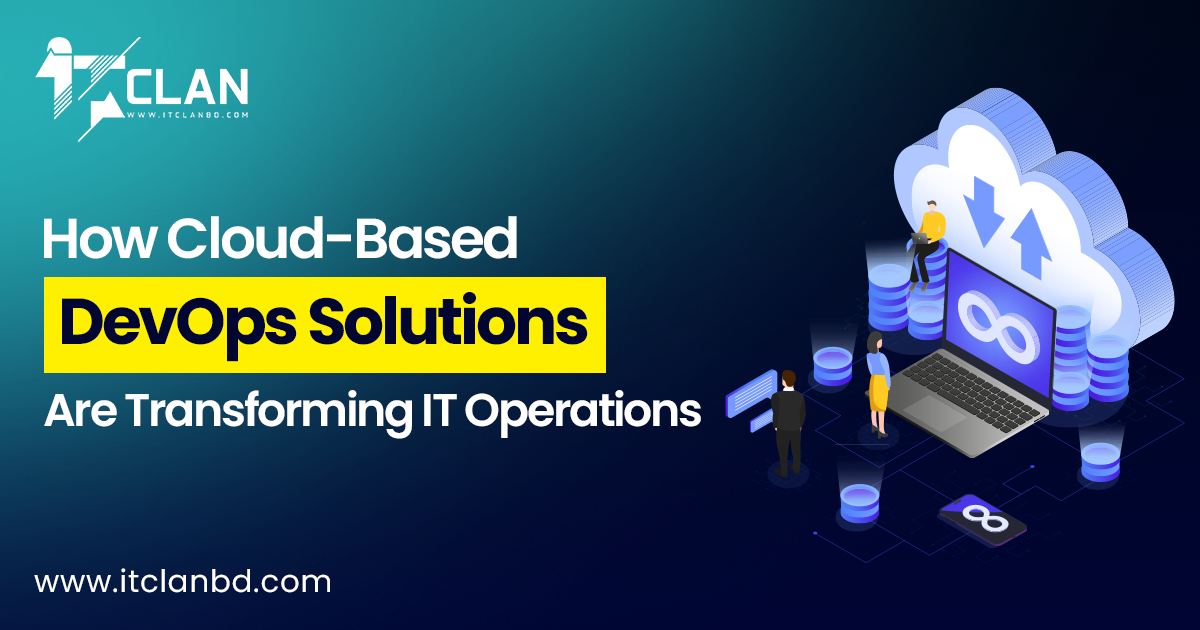
Our Blog Details
Home / Our Blog DetailsThe technology is upgrading fast, as well as, businesses can’t afford to wait weeks or months for software updates. Customers expect smooth experiences, fast features, and quick fixes when something goes wrong. That’s where DevOps comes in, and more specifically, cloud-based DevOps solutions.
But what exactly is cloud-based DevOps, and why is it changing the way IT operations work? If you’ve ever wondered how companies keep their software running flawlessly while constantly improving it, this blog is for you.
We’ll break it down, answer common questions, and show how adopting cloud-based DevOps can revolutionize your IT operations.
What is Cloud-Based DevOps
Let’s start with the basics.
DevOps is a combination of development and operations practices that helps teams deliver software faster and more reliably. Traditionally, DevOps involved on-premise servers and infrastructure, which could be slow, costly, and complex to manage.
Cloud-based DevOps takes all of this to the cloud. Instead of relying solely on physical servers and local infrastructure, teams use cloud platforms to develop, test, deploy, and monitor applications. This approach is more flexible, scalable, and accessible from anywhere.
Think of it like this: traditional DevOps is like having your own workshop with all the tools you need. Cloud-based DevOps is like renting a high-tech workspace where you can instantly access the latest tools, storage, and computing power without worrying about maintenance or hardware failures.
Why Cloud-Based DevOps Matters
You might be wondering, “Why should my business switch to cloud-based DevOps? Can’t we stick with traditional methods?” Here’s the thing: IT operations today face more pressure than ever. Applications are more complex, users demand faster updates, and downtime can cost thousands, even millions.
Cloud-based DevOps addresses these challenges by making IT operations faster, smarter, and more reliable. It allows teams to automate repetitive tasks, scale resources as needed, and collaborate more effectively. The result is fewer errors, quicker updates, and happier customers.
To learn more about how DevOps can boost software delivery and quality, check out this detailed guide.
Benefits of Cloud-Based DevOps Solutions
Let’s dive into the tangible benefits. These are the reasons why companies around the world are moving their DevOps processes to the cloud.
1. Faster Development and Deployment
One of the biggest advantages of cloud-based DevOps is speed. Using cloud-hosted continuous integration and continuous deployment (CI/CD) tools, teams can develop, test, and deploy updates in record time.
For example, developers can push new code, and automated pipelines run tests, build the application, and deploy it without manual intervention. This reduces delays and human errors, allowing companies to release updates weekly, daily, or even multiple times a day.
Want to dive deeper? Check out our blog on how DevOps automation is revolutionizing the software development process.
2. Scalability and Flexibility
Traditional IT operations require careful planning for hardware, storage, and network capacity. Cloud-based DevOps eliminates this headache.
Need more computing power for a big release? You can instantly scale resources up in the cloud. Don’t need them anymore? Scale down and save costs. This flexibility allows businesses of all sizes to adapt quickly without investing in expensive infrastructure.
3. Better Collaboration
In the past, development and operations teams often worked in silos. Developers wrote code, operations maintained servers, and communication gaps caused delays and errors.
Cloud-based DevOps changes this by providing a unified platform where all teams can collaborate. Everyone has access to the same tools, dashboards, and data, making it easier to track progress, troubleshoot issues, and innovate faster.
4. Improved Security and Compliance
Security is a top concern for IT operations. Cloud-based DevOps solutions often come with integrated security tools, automated compliance checks, and regular updates from cloud providers.
This means your software is not only running efficiently but also securely. You don’t have to worry about manually patching every server or tracking every compliance requirement. The cloud handles a lot of that for you.
Don’t ignore site health—our guide on how regular website maintenance can prevent costly outages shows how to keep your website up, secure, and performing well.
5. Cost Efficiency
Maintaining physical servers, storage, and networking equipment can be expensive. Cloud-based DevOps offers a pay-as-you-go model, so you only pay for what you use.
Instead of spending money on unused servers or maintenance staff, businesses can redirect resources to innovation, customer experience, and growth.
Curious about the budget side of your development project? Discover the full breakdown in our post on the cost to build a website.
6. Real-Time Monitoring and Analytics
With cloud-based tools, IT teams can monitor applications in real-time. Dashboards show performance metrics, user behavior, and potential issues before they become major problems.
This proactive approach allows teams to fix problems quickly, optimize performance, and make data-driven decisions that improve the business.
Want to see how DevOps strengthens agile processes? Check out our blog on why DevOps is the key to agile software development
Popular Cloud-Based DevOps Tools
There are many tools available that make cloud-based DevOps practical and powerful. Some of the most popular ones include:
- AWS DevOps Tools: CloudFormation, CodePipeline, CodeBuild
- Azure DevOps: Pipelines, Repos, Test Plans
- Google Cloud Build: Continuous integration and delivery
- Jenkins X: Kubernetes-native CI/CD
- GitLab CI/CD: All-in-one DevOps platform
Each tool has unique features, so businesses can choose what fits their workflow best. A good rule of thumb is to focus on tools that integrate well with your existing processes, simplify collaboration, and allow automation at scale.
For those also working on design alongside development, check out our guide on the best tools for UI/UX designers to ensure a smooth design-to-development workflow.
Real-World Impact on IT Operations
Cloud-based DevOps isn’t just theoretical—it has real, measurable effects on IT operations.
- Reduced Downtime: With automated monitoring and fast deployment pipelines, teams can address issues before they cause outages.
- Faster Feature Delivery: New features and updates reach customers faster, improving satisfaction and competitiveness.
- Cost Savings: On-demand resources reduce infrastructure costs, and automation lowers the need for manual intervention.
- Better Incident Response: Teams can track, analyze, and fix issues in real-time, keeping systems stable and users happy.
For example, a retail company moving to cloud-based DevOps reported a 40% faster release cycle, a 30% reduction in downtime, and significant cost savings from using on-demand resources. These improvements aren’t rare—they’re becoming standard in industries that embrace cloud DevOps.
Some Challenges and How to Overcome Them
Of course, moving to cloud-based DevOps isn’t without challenges. Some common hurdles include:
- Migration Complexity: Moving existing applications and infrastructure to the cloud can be tricky.
- Training Needs: Teams need to learn new tools, processes, and cloud best practices.
- Vendor Lock-In: Relying heavily on a single cloud provider can limit flexibility.
The good news is that these challenges are manageable:
- Adopt a phased approach instead of moving everything at once.
- Invest in team training and support.
- Consider multi-cloud or cloud-agnostic strategies to avoid lock-in.
With careful planning, businesses can navigate these challenges and enjoy the full benefits of cloud-based DevOps.
The Future of Cloud-Based DevOps
The future of IT operations is exciting. Cloud-based DevOps is evolving with trends like:
- AI and Machine Learning: Smarter automation for testing, monitoring, and deployment.
- Serverless Computing: Less infrastructure management and more focus on coding and innovation.
- Edge DevOps: Managing applications closer to users for faster response times.
Businesses that embrace these innovations will stay competitive, deliver better user experiences, and respond faster to market demands.
Boost Your IT Operations with ITclan BD’s DevOps Expertise
If you’re looking to make the most of cloud-based DevOps without the stress of figuring it all out yourself, ITclan BD is here to help. Our team specializes in implementing DevOps solutions tailored to your business needs, whether it’s setting up automated CI/CD pipelines, managing cloud infrastructure, or optimizing IT operations for speed and reliability.
With our guidance, you can focus on innovation while we take care of the technical heavy lifting. Think of us as your partner in transforming IT operations—making your processes faster, smarter, and more efficient, so your team can deliver better software and happier customer experiences.
Conclusion
Cloud-based DevOps is more than a technological upgrade, it’s a business transformation. It makes IT operations faster, more reliable, cost-efficient, and secure. It empowers teams to collaborate seamlessly, innovate quickly, and respond to customer needs without the usual bottlenecks.
If your business is still relying solely on traditional DevOps methods, now is the time to explore cloud-based solutions. The benefits are real, measurable, and can give your business the edge it needs in today’s digital world.
By adopting cloud-based DevOps, you’re not just improving IT operations, more than that, you’re setting your business up for faster growth, happier customers, and long-term success.
Frequently Asked Questions
Cloud DevOps helps businesses deliver software faster, reduce downtime, scale easily, and cut costs. It makes IT operations more agile and efficient, which is vital in today’s fast-paced digital world.
Popular tools include Jenkins, GitLab CI/CD, CircleCI, Terraform, AWS CloudFormation, Azure DevOps, Docker, and Kubernetes. Choosing the right tool depends on your team, workflow, and infrastructure.
It reduces downtime with better monitoring, increases deployment speed via automated pipelines, and lowers costs by using cloud resources efficiently. Overall, it improves performance and customer experience.
Yes. Startups benefit from rapid scaling and agility, while large enterprises can modernize operations. The key is aligning tools, processes, and culture with your business goals.
Start small with a pilot project, choose tools that fit your team, automate CI/CD and monitoring, foster collaboration, and gradually expand. Learning as you go ensures smooth adoption.
Recent Blog Post
Quality Is Our Strength

Voice Search Optimization: The Next Frontier in SEO...
Have you ever asked Google Assistant to “find the best restaurant near me”? Or did you tell Siri to “play relaxing music”?If yes, then you’ve already used voice search, which is o...

How Cloud-Based DevOps Solutions Are Transforming IT Operati...
The technology is upgrading fast, as well as, businesses can’t afford to wait weeks or months for software updates. Customers expect smooth experiences, fast features, and quick fixes whe...

The Benefits of Continuous Integration and Continuous Deploy...
Right now, software development is no longer about releasing updates once in a blue moon. Users expect frequent updates, faster features, and bug-free experiences. This is where Continuous ...
